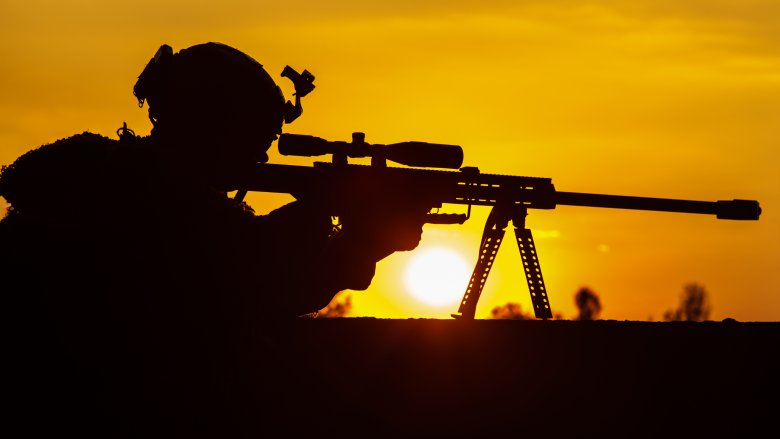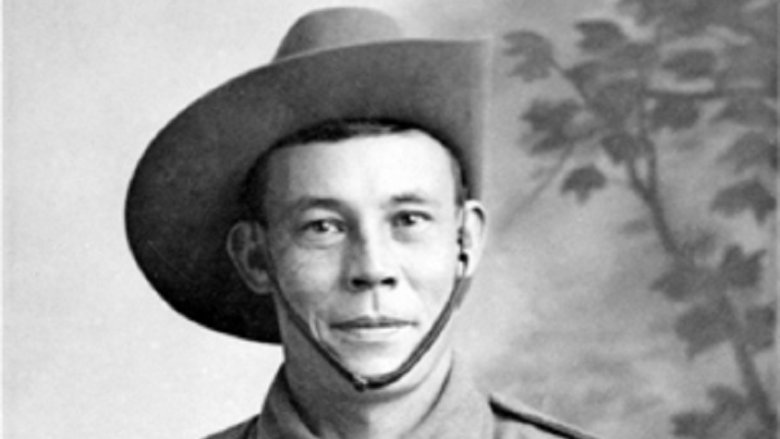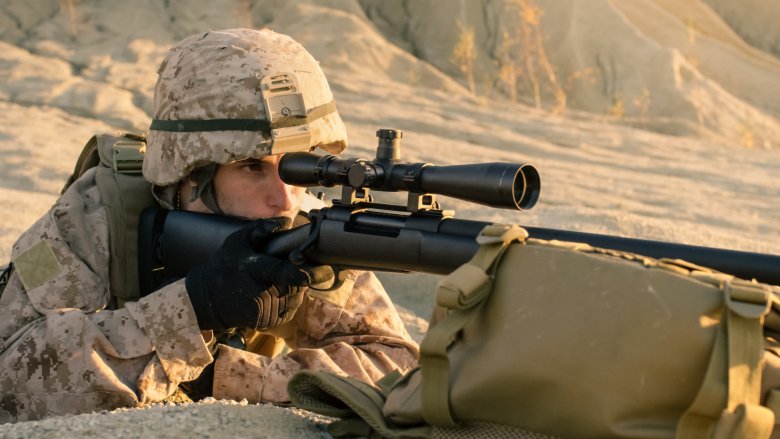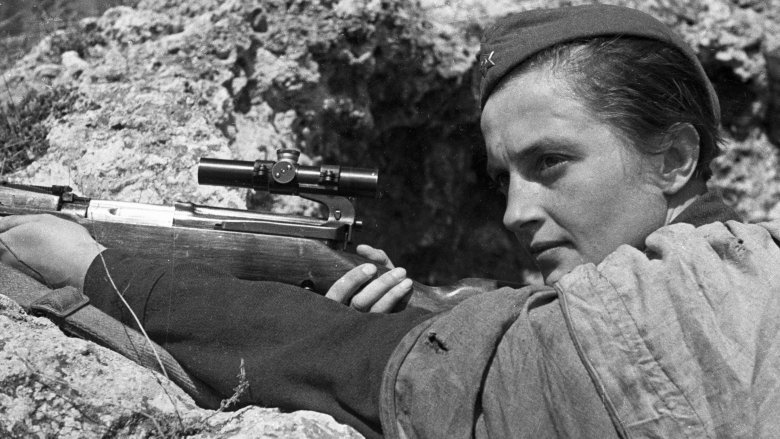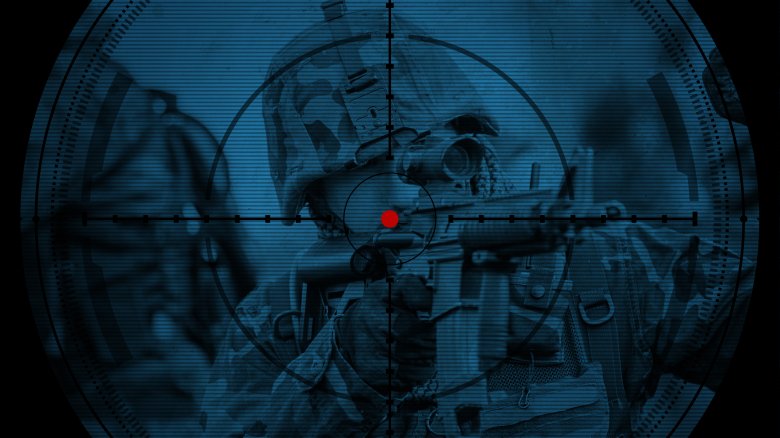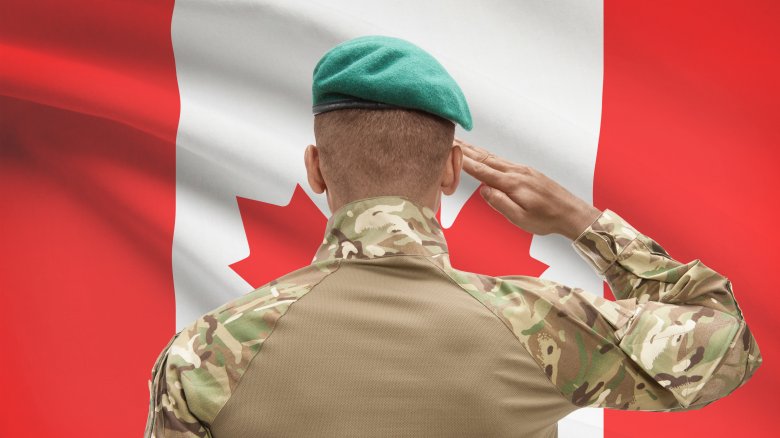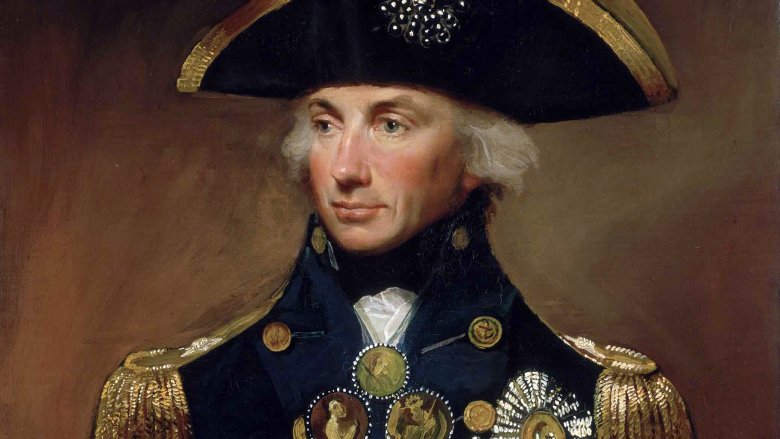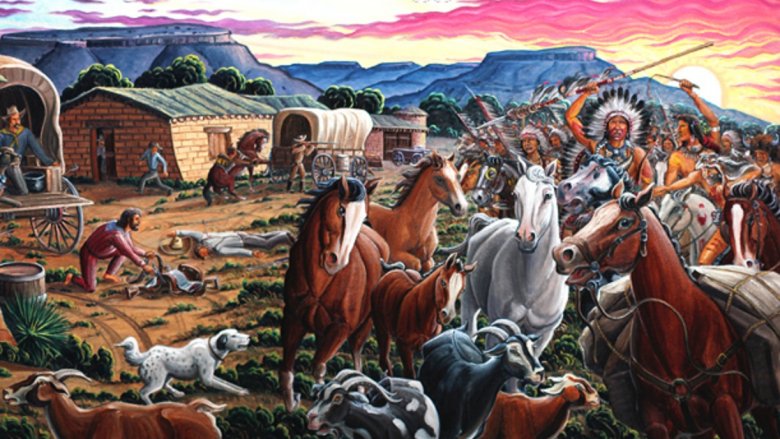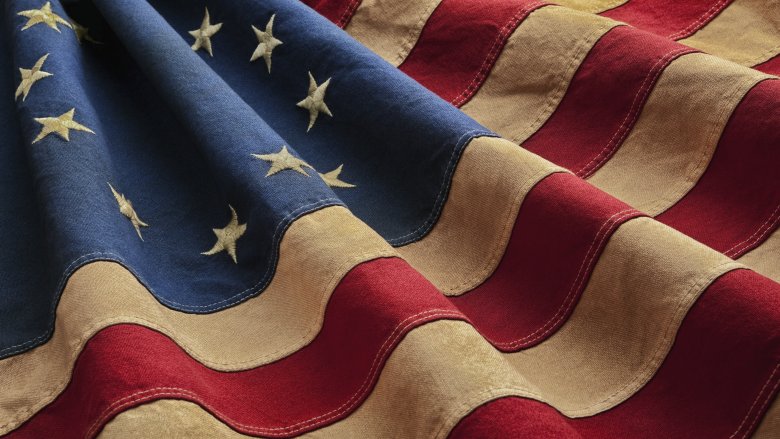History's Most Famous Sniper Shots
Snipers turn death into a magic trick, but they don't aim to entertain. Through the slightest of hand movements they make life disappear in an unseen instant. The gun is their wand, the bullet their assistant. No one is their audience until it's too late. They are skilled inhumanity incarnate, and the world both fears and reveres them for it. However, some snipers stand out more than others. They are the Houdinis of demise and the Copperfields of carnage, individuals whose deft deadliness earned them macabre admiration. Below are some of their most well-known trick shots.
The showdown at Gallipoli
During the early 20th century, the most dangerous Australian animal was a man named Billy Sing (pictured above). Per The Sydney Morning Herald, Sing could supposedly "shoot the tail off a baby pig at 25 paces." But rather than spend his time disfiguring swine heinies, the sharpshooter kicked butt in World War I as part of the Chinese-Australian Anzacs. While stationed at Gallipoli, he earned the fear of foes by systematically slaughtering them. Opposing Ottoman forces soon saw Sing as a huge problem and looked to Turkish sniper Abdul the Terrible for the solution.
Journalist Ion Idriess, who fought at Gallipoli, described Abdul as "the pride of the Turkish Army," according to The Sydney Morning Herald. His rifle was called the "Mother of Death" because it gave "birth to bullets which destroy the lives of men." If there was anyone who could end Sing, it was Abdul. The Turkish terror discerned Sing's location after estimating bullet trajectories by checking the wounds of nearby corpses. Then he dug a foxhole and readied his rifle.
Unfortunately for Abdul, Sing saw him first. The latter lay in wait for the perfect moment to open the peephole in his hideout and pick off his pursuer. As Idriess recounted, "Gently the peephole widened, then stopped close around the rifle. Abdul waited with finger on trigger, just awaiting that loophole to open the least fraction more. And -– a bullet took him between the eyes." The problem had solved the solution.
One bullet, six Taliban
In the 1981 Filipino action flick San Basilio, hilariously masked hero Julio Valiente takes out two foes simultaneously by shooting at his own knife, which (ridiculously) splits a bullet into two man-seeking missiles. It's possibly the greatest kill in the history of cinema and certainly one of the most improbable. Yet in 2014, reality easily topped it.
According to The Telegraph, a 20-year old British sniper stationed in Afghanistan killed not two, but six Taliban members with a single pull of the trigger. But rather than trying to slice a bullet with a five-pronged fork or something, he detonated a dude wearing a suicide vest. It just so happened that said dude was surrounded by five fellow fighters when the fireworks went off. The Daily Beast hailed the incident the incident as "The greatest sniper shot in history," noting that British brass believed it was unprecedented in modern warfare.
In all likelihood, the anonymous gunman foiled an impending Taliban attack. British forces later discovered an undetonated vest that held 44 pounds of explosives near the site of the explosion. Clearly, at least some of those fighters had every intention of dying, just not by the hand of someone standing 930 yards away. Unfortunately for them, Death had other plans.
Lyudmila Pavlichenko's three-day duel
Eagles and sickles are natural adversaries, which is why you never see them palling around in the wild. Yet somehow, Eleanor Roosevelt and Soviet super sniper Lyudmila Pavlichenko had a years-long friendship that didn't include spontaneous face-punching. That's partly because when they first met, it was 1942, and the USSR wanted the USA's help in tearing Hitler a new mustache. Pavlichenko was visiting America to promote that agenda, according to Smithsonian Magazine. Moreover, both women vocally supported gender equality. Perhaps the biggest reason to make friends was that Pavlichenko's enemies had a habit of dying.
Pavlichenko remains history's most prolific female sniper with a staggering 309 kills to her name. As the book Warrior Women detailed, all of those fatalities occurred over the course of a year before a mortar blast ended her rifle reign in 1942. In a single summer she shot 187 enemies to death.
She also engaged in 36 separate sniper duels, all of which she won. One of those showdowns lasted three days. Pavlichenko recalled it as "one of the tensest experiences of [her] life." It required her to stay put for 15 to 20 hours at a time before her would-be executioner eventually "made one move too many." In the game of literal bullet chess Pavlichenko was the quintessential queen.
The coconut tree kill
When people hear "Vietnam War," they often think of napalm nightmares and Agent Orange groves or tense battles between choppers and Charlie. But American marksmen also made their mark. In fact, Michael Lanning's Inside the Crosshairs: Snipers in Vietnam deemed sniper teams "the war's most efficient 'weapon systems.'" In other words, they were excellent killers. But even the best men have a best man, and in Vietnam, that man was Sergeant Adelbert Waldron III.
Per The Military Times, Waldron is one of America's most highly decorated snipers. He served in both the Navy and the Army and risked his life multiple times for his fellow soldiers. During the Vietnam War, Waldron partook in 14 sniper missions and recorded 109 kills. He would later receive a Distinguished Service Cross for acts of bravery. Obviously, Waldron's exploits were many, but one in particular showed the sniper's frightening lethality.
Lieutenant General Julian J. Ewell, who served alongside Waldron, recalled an instance when the renowned rifleman shot an enemy sniper while standing on a moving boat: "While everyone else on board strained to find the antagonist, who was firing from the shoreline over 900 meters away, Sergeant Waldron took up his sniper rifle and picked off the Vietcong out of the top of a coconut tree with one shot (this from a moving platform). Such was the capability of our best sniper." The lesson: never rock a sniper's boat.
Hathcock's scope shot
Carlos Hathcock was basically a bullet whisperer. A self-taught sharpshooter and Wimbledon Cup shooting champion, his talent was virtually unrivaled. The same proved true when he fought in Vietnam. According to Military.com, the rifleman racked up 93 confirmed kills, though the actual tally might be closer to 400.
Despite his knack for long-range homicide, Hathcock saw death as an odious necessity rather than a goal. As he put it: "You'd have to be crazy to enjoy running around the woods, killing people. But if I didn't get the enemy, they were going to kill the kids over there." Even so, there were a few lives he eagerly ended. According to Hathcock, his greatest shot dropped a woman named Apache who delighted in torturing Marines. But he's most remembered for a duel with a dude called the Cobra.
For context, the North Vietnamese had placed a $30,000 bounty on Hathcock's head, and the Cobra intended to collect. To achieve that end, the Cobra began murdering Marines in hopes of luring Hathcock into the open. The sociopathic ploy nearly worked. The Cobra took a shot at Hathcock and his partner, but only blew a hole in Hathcock's partner's canteen. When Hathcock tracked him down, he didn't miss: "I was just quicker on the trigger, otherwise he would have killed me. I shot right straight through his scope, didn't touch the sides."
The 2-mile kill shot
A lot can get accomplished in 10 seconds. You can microwave a honeybun to the perfect temperature and taste. You can get fired from a lucrative job by coughing in the boss's face. An especially efficient couple could even conceive a child. In 2017, a Canadian sniper took 10 seconds to make military history.
According to CNN, an unknown member of the maple leaf militia -– formally known as Canada's Joint Task Force 2 special operations unit –- killed an ISIS fighter from a distance of 3,540 meters, or approximately 2.2 miles. The shooter was reportedly assisting Iraqi troops who were under attack in Mosul. Some service members met the news with disbelief, presumably noting that ACME physics seem more realistic. The Canadian military, however, confirmed the shot, officially making it the longest kill on record.
Canadian Prime Minister Justin Trudeau was elated. Newsweek reported that Trudeau touted the shot as an example of "the excellence of the Canadian Forces in their training and their performance of their duties." He has a point. Of the five longest known sniper kills in military history, Canadians accounted for three of them at the time of this writing. That's like finding out that Care Bears are the world's deadliest carnivores.
Chris Kyle's long shot
American Sniper is ironically associated with inaccuracy. The Hollywood-hewn story of Navy Seal Chris Kyle faced criticism for fictionalizing the sniper and being tonally off-the-mark, per NPR. The film also inserted several battlefield embellishments, including a rifle rivalry between Kyle and Syrian sniper Mustafa, who gets portrayed as a kind of anti-Kyle. Ultimately, the American wins the day, killing his foe from 2,100 yards (roughly 1.2 miles).
As The Washington Post and others pointed out, the real-life Kyle apparently never saw, let alone shot, Mustafa. However, he purportedly did pull off a mile-long shot. In Kyle's autobiography (via The Washington Post), he recalled taking out an insurgent who was poised to blow some Marines to smithereens with a rocket-propelled grenade.
Kyle was perched on an Iraqi rooftop when he spotted the makings of a fiery tragedy. In his words: "Maybe the way the way I jerked the trigger to the right adjusted for the wind. Maybe gravity shifted and put that bullet right where it had to be. Maybe I was just the luckiest son of a b***h in Iraq. Whatever — I watched through my scope as the shot hit the Iraqi, who tumbled over the wall to the ground." If you question those words, that's understandable. Kyle was later successfully sued for defamation in an unrelated case. However, as of this writing, no one has publicly disputed the above anecdote. Either way, it defined Kyle as a man and a myth.
The Trafalgar sea snipers
As crazy as it sounds, during the early 1800s the British were in serious danger of being overrun by another nation. As the History Channel detailed, France had militarily towered over much of Europe despite not yet having an Eiffel Tower and had turned its attention to Tea Land. England would rely on its naval might to keep from getting blown apart by the complex Napoleon Bonaparte. Instrumental in that defense was Vice Admiral Horatio Lord Nelson (shown above), which is about as British-sounding a name as Jeeves Crumpet-Strumpet, Duke of Poshington.
In 1805, Nelson commanded a fleet of 27 ships against 33 French and Spanish vessels during the Battle of Trafalgar. The sides pummeled each other for hours. Ultimately, the English won, but they lost Nelson in the process. According to the book Special Forces: Sniper Skills, French captain Jean-Jacques Lucas had an elite team of sea snipers who excelled at lobbing grenades and shooting from ship masts. And since naval officers wore ornate outfits, Nelson was essentially a flowery bull's-eye. A sniper's bullet struck the British admiral in the left shoulder, "cut down through his lung, and came to a rest at the base of his spine."
Nelson lived long enough to learn that the British had triumphed. Upon hearing the news, he proclaimed, "Now I am satisfied. Thank God I have done my duty." And he had. After losing on the high seas, Napoleon never again sought to invade England.
The 'shot of the century'
Billy Dixon was the stuff Westerns are made of. He was an orphan, an oxen driver, a mule skinner, and a scout. He hunted and battled and traveled about. But in 1874 he just wanted a home where the buffalo roamed so he could shoot them. According to the Amarillo Globe-News, that home ended up being Adobe Walls, a settlement in the Texas panhandle. Accompanying Dixon was a herd of buffalo hunters.
The settlement proved unsettling for nearby Native Americans, who had already attacked the installment 10 years prior. As Rifle Shooter Magazine described, members of the Comanche, Kiowa, Cheyenne, and Arapaho banded together for a repeat performance. In June 1874, they pounced. The settlers were outnumbered 30 to 1.
The odds were awful, but Dixon had an equalizer: a .50-90 buffalo rifle. After three days of fighting, he settled matters by popping off a single shot. The bullet traveled 7/8 of a mile (1,538 yards) and unhorsed an unsuspecting enemy. Upon witnessing that feat, the warriors retreated. That kill later became known as "the shot of the century." Dixon just called it lucky.
The Saratoga tree sniper
The American Revolution has no shortage of highlights. There was the failed attempt to make tea by tossing it into a harbor, boats, some guy crossing a frosty river, and other stuff. Included in that other stuff was the Second Battle of Saratoga (aka the Battle of Bemis Heights) in 1777, which according to the History Channel, helped swing the war's momentum in America's favor.
Per the New York State Military Museum, during that pivotal skirmish British officers Sir Francis Clerke and General Simon Fraser became involuntary bullet receptacles, causing chaos among the Redcoats. The man credited with those crucial kills was Timothy Murphy, who was allegedly "able to hit a seven-inch target at 250 yards." As AmericanRevolution.org recounted, the marksman was part of a 500-person crew picked to pick off British troops besieging New York. On orders from a pre-traitorous Benedict Arnold, the men focused their fire on General Fraser. Murphy purportedly planted himself in a tree, took aim, and felled Fraser from 300 yards away. He then capped Sir Clerke, who died "before he hit the ground."
With two bullets Murphy bested the British and became a legend. But according to author and journal editor Hugh Harrington, Murphy's heroics were only a legend. Citing multiple sources, Harrington dismissed the story as unproven poppycock. Per his research, the first mention of Murphy emerged 68 years after the battle. Since Murphy's not around to clarify what happened, the truth is anyone's guess.
